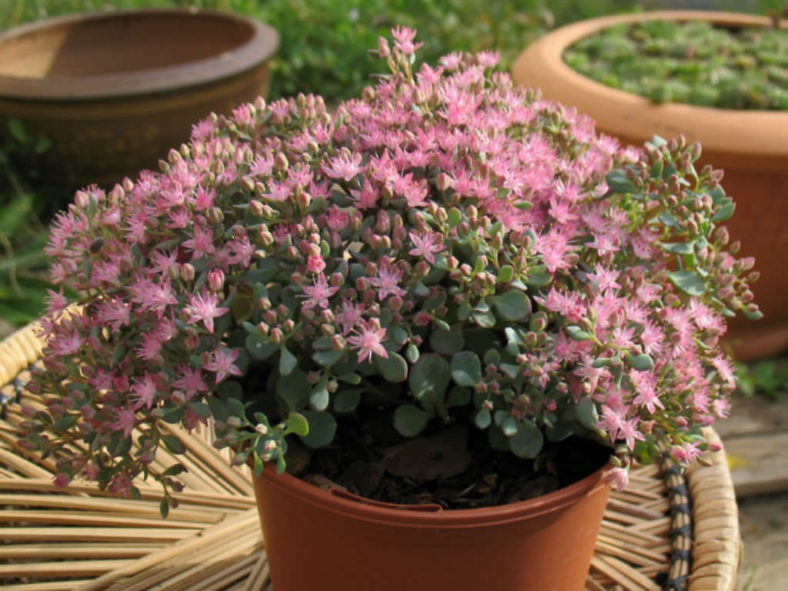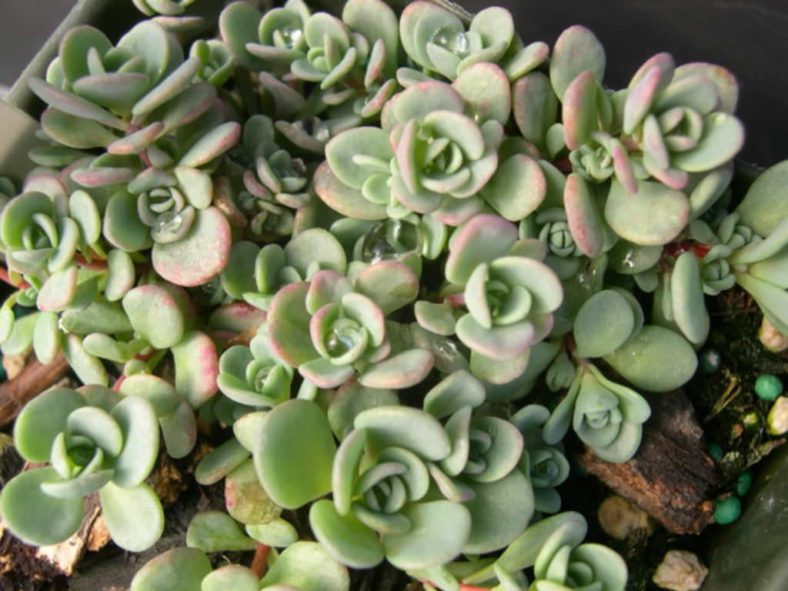Scientific Name
Hylotelephium pluricaule (Maxim.) H. Ohba
Synonym(s)
Hylotelephium triphyllum var. pluricaule, Sedum hidakanum, Sedum pluricaule, Sedum telephium var. pluricaule
Scientific Classification
Family: Crassulaceae
Subfamily: Sempervivoideae
Tribe: Telephieae
Genus: Hylotelephium
Etymology
The specific epithet "pluricaule" (pronounced "ploo-ree-KAW-lee") means "having several stems" and refers to the growth habit of this species.
Origin
Hylotelephium pluricaule is native to the Russian island of Sakhalin in the North Pacific.
Description
Hylotelephium pluricaule, formerly known as Sedum pluricaule, is a small succulent with erect, ascending, or sometimes pendulous stems with ovate, densely arranged leaves. It can grow up to 2.4 inches (6 cm) tall, forming a low mound with age. The stems can reach up to 4 inches (10 cm) in length. The leaves are fleshy, blue-green, and flushed with pink, measuring up to 1 inch (2.5 cm) in length and 0.4 inches (1 cm) in width.
The flowers are star-shaped, pink with reddish-purple anthers, and appear in terminal clusters from late summer to fall. The foliage dies back to the ground in the winter. In the spring, new stems arise from the base of the old stems.

How to Grow and Care for Hylotelephium pluricaule
Light: This succulent prefers full sun. It tolerates light to partial shade in hot summer climates but will produce weak, floppy growth when grown in too much shade. Plant your H. pluricaule in an area of your garden with 6 hours of sunlight daily.
Soil: H. pluricaule does not need rich soil, but it does require excellent drainage. Choose a commercial potting mix for succulents, or make one yourself.
Temperature: This plant is cold-hardy and tolerant of heat and drought, making it a popular choice for outdoor succulent cultivation. H. pluricaule can withstand temperatures as low as -20°F (-28.9°C). USDA Plant Hardiness Zones 5a to 9b, -20°F to 30°F (-28.9°C to -1.1°C).
Watering: The best method for watering H. pluricaule is the "soak and dry." Get the soil completely wet, and then wait until it is dry before watering again.
Fertilizing: Apply a balanced fertilizer annually. According to the package directions, apply the fertilizer to the soil in spring as new growth appears.
Repotting: Plants in containers require little more care than those in gardens. Repot your H. pluricaule when it outgrows its current pot by moving it to a larger one to provide better support for the plant. Spring is the best time to repot this plant. Ensure the soil is dry before starting the repotting process.
Propagation: This succulent can be grown from seeds, division, or stem cuttings. Sow the seeds in spring. Dividing your H. pluricaule is easy and can be carried out at almost any time in the growing season, though it is probably best done in spring or early summer. Propagate by stem cuttings in summer.
Learn more at How to Grow and Care for Hylotelephium.
Toxicity of Hylotelephium pluricaule
H. pluricaule can be mildly toxic to humans and animals.
Links
- Back to genus Hylotelephium
- Succupedia: Browse succulents by Scientific Name, Common Name, Genus, Family, USDA Hardiness Zone, Origin, or cacti by Genus
Photo Gallery
Click on a photo to see a larger version.


